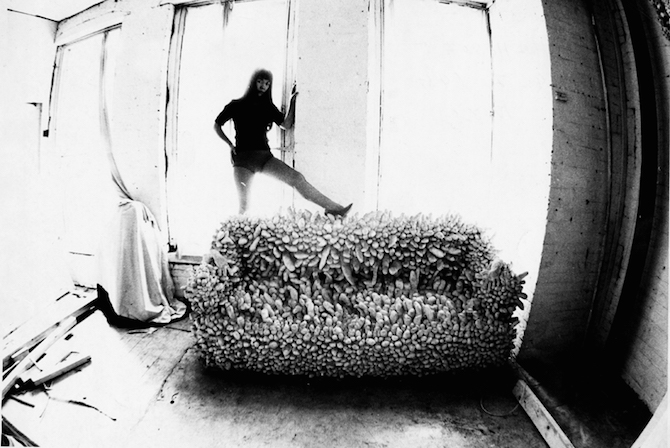Search
To search for an exact match, type the word or phrase you want in quotation marks.
A*DESK has been offering since 2002 contents about criticism and contemporary art. A*DESK has become consolidated thanks to all those who have believed in the project, all those who have followed us, debating, participating and collaborating. Many people have collaborated with A*DESK, and continue to do so. Their efforts, knowledge and belief in the project are what make it grow internationally. At A*DESK we have also generated work for over one hundred professionals in culture, from small collaborations with reviews and classes, to more prolonged and intense collaborations.
At A*DESK we believe in the need for free and universal access to culture and knowledge. We want to carry on being independent, remaining open to more ideas and opinions. If you believe in A*DESK, we need your backing to be able to continue. You can now participate in the project by supporting it. You can choose how much you want to contribute to the project.
You can decide how much you want to bring to the project.

The life and work of Yayoi Kusama, the 88-year-old Japanese artist revived from the dustbins of history and now immensely popular, are habitually described in exotic, outsider terms, in line with the counter-heroic accounts preferred for popularized art: her success in the United States in the 1960s; a certain involution, ending with her committing herself to a mental health institution in Tokyo in 1977, where she still lives; the unexpected and undeniable triumph of her golden years. This mythification clearly ignores her express intention to fully integrate herself into the New York scene, which she ended up doing rather comfortably. The eccentricity of red-haired Kusama, from the perspective of the Western machinery of cultural reception, seems to have been reinforced by her condition as an elderly, non-conformist woman, an extravagant survivor.
In the reading that corresponds to her and is fostered, everything is kept alive, without renouncing a single thing, as if it really were possible to imagine a seamless creative career. From here we might derive one of the main debates involving her work: her production has been long and complex but not particularly evolutive, holding faithful to a set of primary modernist values: humanism; the resistance of the individual; recourse to organic forms; aesthetic unification. Kusama gives priority to everything human beings share, obsessions included, over and above differentiating factors. This is hardly altered at all by her interest in exploring her long-suffering psychological and sexual subjectivity (she describes herself as someone who is debilitated, despite many performances celebrating sexual freedom). As seen with many creators marked by the Second World War, the shared tragedy became an impulse towards cohesion, allowing artists to speak from out of a plethora of subjectivities on the universal condition. Kusama has not wavered from her search for harmony as an aesthetic and ethical value, as she continually domesticates the oddest, most pathological idiosyncrasies. Her success, like her work, is fully modern.
The retrospective launched by the Hirshhorn in Washington, which I was able to visit at the Seattle Art Museum (SAM) in July of 2017, particularly stands out for six environments or spatial ambiences, the much-lauded “Infinity Mirror Rooms”. Some were conceived in the 1960s and have here been updated; others are more recent creations, such as Infinity Mirrored Room – Aftermath of Obliteration of Eternity (2009), a beautiful composition of light and movement. Some are completely closed-off rooms, in full surround; others work as peep shows, where you look from the outside in through small apertures. In total Kusama has made some twenty of these rooms, many of which were ephemeral and have since been lost. They constitute, without a doubt, the “spectacular” draw that has turned this touring show into an unprecedented success: tickets at the SAM were no longer available months before closing, while at the next venue, the Broad in Los Angeles, everything was sold out before opening night, requiring the museum to expand visiting hours. For those without a ticket queues are endless, a fact which contrasts with the shortened experiences dictated for each “Infinity Room”, where small groups are given some thirty seconds inside each space to fully absorb the dizzying, highly playful array of mirrors, lights, colour and movement, a totally inadequate amount of time for the work’s reception (though one, we are told, that was approved by the artist).

The importance of the “Infinity Mirror Rooms” for Kusama’s work is by no means negligible. In Japan, in the 1950s, she produced many drawings with gouache and pastel, repeating cellular forms that were often accumulated inside of amorphic enclosures that recall amoeba floating over misty fields. Another body of work from the decade, the “Infinity Nets”, are pictorial all-overs composed of light or greyish toned rhythms over white grounds, bitonal meshes that are both calming and obsessive. What the “Infinity” environments really do, beginning with Infinity Mirror Room – Phalli’’s Field (Floor Show) (1965/2016), is reproduce the main principles and pictorial motifs in Kusama’s work in formats that are multidimensional and maxi-sensorial, inviting the viewer to be drawn in from all sides. In original photographs, we see Kusama laying out over top of these pieces (exhibiting herself with similar luxuriance in her performance work), a personal stamp of authorship and sensuality, her body offered as signature.
It is often said that Kusama, when still a child, had hallucinations where she saw tiny point and flashes of fractured light, the inspiration for the burst of points, dots and sparkling sequences in her work, which also make their way into her clothing (where large polka-dots hold sway). Alternatively, the presence in nature of clusters – the eroded stones in a river, or the ordered seeds of a pumpkin, the specific motif of Infinity Mirrored Room – All the Eternal Love I Have for the Pumpkins (2016) – reconnects Kusama to her rural childhood, amidst animate, pantheistic landscapes. As she herself explains, this all fell apart when she had to work in a dark, foreboding factory during the war under the Allied bombings. For my part, I find this insistence on attributing formal recurrences of a mature creator to childhood circumstances and traumas rather gratuitous.
After her early success in Japan, Kusama travelled to the United States in search of greater artistic freedom and company, arriving in Seattle in 1957 (the circumstances of which are well-documented at the SAM). Like her, many Japanese artists had integrated their work into international discourses related to cultural reconstruction in the post-war, such as the collectives Jikken Kobo (Experimental Workshop), the radicals of Gutai and the minimalists associated with Mono-Ha; Kusama, in contrast, took a more independent path. Soon, in New York, she began to add soft sculptures to the two-dimensional work: small, cotton sheathes in long, phallic shapes, either white or printed in coloured dots, were bunched together to texture chairs and other kinds of furniture (which places her amongst the pioneers of radical design, normally associated with Italian currents which arose later). One of her soft couches, Accumulation No. 2 (1962), was included in a group show together with work by Warhol, Morris, Rosenquist and Oldenburg. Her critical success was unflagging during the decade, featuring a series of performances, encounters and happenings, often in the public space. Those performances where she was seen naked set up a counterpoint with what she said of her own sexuality, repressed from an early age, one of the most finely-tensed features of her creative biography.

Poor mental and physical health would eventually lead her to return to Japan in 1973, where a few years later she would set up permanent residence in the Seiwa mental health centre, in Tokyo. With her studio nearby, she continued to make work, as well as writing essays and novels. Set apart yet not retired, the first attempts at reviving her career would come along in the 1990s, and so on until the present day. In September 2017, she inaugurated a new museum dedicated exclusively to her work, built in Tokyo.
Clearly not everyone finds it easy to accept the entertaining optimism Kusama has chosen to project, her playful will, those loud visual displays we now understand as borrowed from Pop Art, all easily assimilated by the mass public. Despite this, the popular success of Kusama confirms the ongoing relevance of the modernist discourse of the twentieth century, humanist, universal and fully committed to a border-crossing language, ever-prepared to elude the more incommensurable, dubitative parameters posited by contemporary art in its most recent manifestations.

"A desk is a dangerous place from which to watch the world" (John Le Carré)